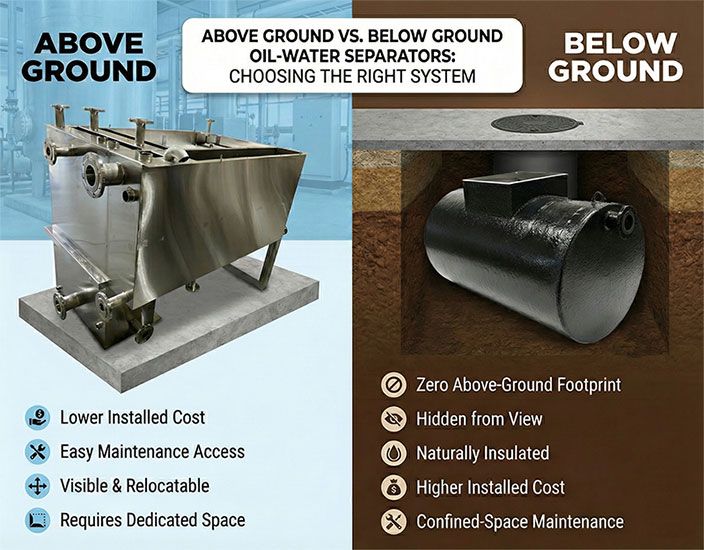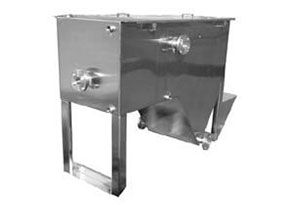Summary
Above-ground and below-ground oil-water separators both remove free oils, grease, and settleable solids from wastewater, but they differ dramatically in installation cost, space requirements, maintenance access, and performance in cold climates. This article provides a clear decision framework plus real-world examples so facilities can select the optimal system and avoid expensive mistakes.

Table of Contents
Introduction
Oil-water separators are required in countless industries, like vehicle maintenance facilities, food processing plants, refineries, transportation depots, and manufacturing sites to name a few. Anywhere oily wastewater is generated will require a separator. While both above-ground and below-ground systems achieve the same regulatory goal (typically < 10-15 mg/L oil and grease in effluent), the installation type dramatically affects upfront cost, ease of maintenance, and long-term reliability. This guide explains when to choose each type.
How Oil-Water Separators Work (Both Types)
All gravity-based API-421 and enhanced coalescing separators operate on the same principles [1]:
- Wastewater enters a forebay where heavy solids settle.
- Flow passes through coalescing media (plates or packs) that force small oil droplets to merge into larger droplets.
- Free oil rises to the surface and is skimmed or pumped off.
- Clarified water exits below the oil layer.
The difference is purely in packaging and installation location.
Above-Ground Oil-Water Separators
Description
Factory-built units mounted on a concrete pad or steel skid, typically constructed of stainless steel or coated carbon steel.
Best Applications
- Cold climates prone to freezing and where units can be installed indoors
- Sites with high water tables or rocky soil
- Facilities that prioritize easy inspection and cleaning
- Leased properties or temporary operations
- When future relocation or expansion is anticipated
Advantages
- Lowest total installed cost (often 40-60% less than buried)
- Full visual access for maintenance and spill response
- No confined-space entry required
- Easy to expand or relocate
- No risk of flotation or crushing from groundwater
Limitations
- Requires dedicated outdoor or indoor space
- Exposed to weather (requires insulation in cold climates if installed outdoors)
Below-Ground Oil-Water Separators
Description
Poured concrete foundation for anchoring, or fiberglass vaults buried flush with grade, typically with traffic-rated covers.
Best Applications
- Space-constrained urban sites
- Facilities wanting a clean, uncluttered appearance
- Warm climates or cold below frost line
- Permanent installations where aesthetics matter
- Stormwater collection where flow by gravity is important
Advantages
- Zero above-ground footprint
- Naturally insulated by surrounding soil
- Hidden from view (important for retail and food-service locations)
Limitations
- 2-3x higher installed cost due to excavation and backfill
- Maintenance more expensive; requires vac truck to empty stored oil
- Confined-space entry can be required for cleaning
Head-to-Head Comparison
| Factor | Above-Ground OWS | Below-Ground OWS |
|---|---|---|
| Installed Cost | $10,000 - $90,000 (typical) | $25,000 - $250,000+ |
| Space Required | Dedicated pad or building | None above grade |
| Maintenance Access | Walk-up, no confined space | Confined-space entry required |
| Cold Weather Performance | Excellent (can add heaters/insulation) | Risk of freezing if not below frost line |
| Installation Time | Days to weeks | Weeks to months |
| Lifespan (stainless units) | 25-40+ years | 25-40+ years (if properly vented) |
| Ease of Cleaning | Very easy | Moderate and more costly |
Key Decision Factors and Recommendations
Choose above-ground when:
- Budget is a primary concern
- Site is in a cold or freeze-thaw region
- High water table or rocky soil exists
- Frequent inspection or rapid spill response is needed
- Facility may relocate or expand
Choose below-ground when:
- Space is limited
- Local zoning or aesthetics demand no visible equipment
- Year-round ground temperatures stay above freezing
- Permanent installation with minimal future changes
- Stormwater runoff requires separation
- Flow by gravity is important
Pro Tip: Many facilities now install above-ground stainless steel units inside a heated building or enclosure to get the best of both worlds — low cost, easy access, freeze protection, and minimal outdoor footprint.
Challenges and Solutions
- Challenge: Freezing in northern climates → Solution: Above-ground with insulation and heat tracing. Or below ground installation under frost line
- Challenge: Limited space → Solution: Above-ground custom designs or below-ground if excavation is feasible.
- Challenge: Higher initial cost of buried units → Solution: Above-ground systems routinely pay for themselves in 2–4 years through lower installation and maintenance costs.
Conclusion
While both above-ground and below-ground oil-water separators meet discharge requirements, above-ground systems deliver significantly lower total cost of ownership in the majority of applications (especially in cold climates, high water table areas, and facilities that value easy maintenance). For a site-specific recommendation and accurate budgeting, contact the experts at Ecologix Environmental Systems.
Glossary
- API-421: American Petroleum Institute design standard for gravity oil-water separators.
- Coalescing Media: Plates or packs that enhance oil droplet collision and separation.
- FOG: Fats, Oils, and Grease.
Frequently Asked Questions (FAQ)
Q: Can I install a below-ground separator in a cold climate?
A: Only if it is buried below the frost line and properly vented. Alternatively, above-ground units can be fitted with insulation and heaters in freeze-prone areas.
Q: Are stainless steel above-ground units worth the extra cost?
A: Yes — 304/316 stainless units routinely last 30-40 years with minimal corrosion, versus 20-30 years for coated carbon steel with proper maintenance.
Q: Do I still need a permit for an above-ground unit?
A: Usually just a building or zoning permit (far simpler than underground storage tank regulations).
Bibliography
- American Petroleum Institute. “Design and Operation of Oil-Water Separators,” API Publication 421, 1990.
- U.S. EPA. “Managing Used Oil: Answers to Frequent Questions,” https://www.epa.gov/hw/used-oil-management
- Ecologix Environmental Systems product literature and installation records, 2015-2025.

